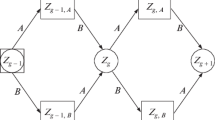Abstract
The theory of homogeneous nucleation is developed for a model nonlinear bistable chemical reaction driven far from equilibrium (trimolecular Schlögl model). The theory is restricted to the vicinity of the stable/unstable transition, where the nucleation barrier is small but nonvanishing. The nucleation rates are derived for two types of fluctuations: first, fluctuations due to a homogeneous external white noise source, and second, internal chemical fluctuations, described by a reastion-diffusion multivariate master equation. In the white noise case, a Landau-Ginzburg potential can be defined, and the standard nucleation formalism can be applied; this is not true for the internal case and a new result is used. The inhomogeneous chemical fluctuations, due to the coupling between the nonlinear reaction and diffusion, are shown to have an influence on the nucleation rate. Quantitative conditions are also given to evaluate the possibility of homogeneous nucleation in nonlinear chemical systems.
Similar content being viewed by others
References
A. N. Zaikin and A. M. Zhabotinskii,Nature 225:525 (1970).
C. Vidal and P. Hanusse,Int. Rev. Phys. Chem. 5:1 (1986).
A. Hanna, A. Saül, and K. Showalter,J. Am. Chem. Soc. 104:3838 (1982).
R. P. Rastogi, I. Das, M. K. Verma, and A. R. Singh,J. Non-Equilib. Thermodyn. 8:255 (1983).
L. M. Pismen,J. Chem. Phys. 71:462 (1979).
P. C. Fife,J. Chem. Phys. 64:554 (1976).
P. Ortoleva and J. Ross,J. Chem. Phys. 63:3398 (1975).
M. P. Wood and J. Ross,J. Chem. Phys. 82:1924 (1985).
Y. Kuramoto and T. Yamada,Prog. Theor. Phys. 56:724 (1976).
D. Walgraef, G. Dewel, and P. Borckmans,J. Chem. Phys. 78:3043 (1983).
C. Vidal, A. Pagola, J. M. Bodet, P. Hannusse, and E. Bastardie,J. Phys. (Paris) 47:1999 (1986).
D. Borgis, Ph. D. Thesis, Université Paris VI (1986).
J. J. Tyson,Ann. N. Y. Acad. Sci. 316:279 (1979).
J. J. Tyson, inOscillation and Traveling Waves in Chemical Systems, R. J. Fields and M. Burger, eds. (Wiley, New York, 1985).
A. Saül and K. Showalter, inOscillations and Traveling Waves in Chemical Systems, R. J. Fields and M. Berger eds. (Wiley, New York, 1985).
H. Metiu, K. Kitahara, and J. Ross,J. Chem. Phys. 64:292 (1976); M. Büttiker and R. Landauer,Phys. Rev. A 23:1397 (1981).
J. S. Langer,Ann. Phys. (N.Y.) 54:258 (1969).
J. S. Langer,Phys. Rev. Lett. 21:973 (1968).
M. Büttiker and R. Landauer,Phys. Rev. Lett. 43:1453 (1979).
G. Nicolis and I. Prigogine,Self-Organization in Non-Equilibrium Systems (Wiley, New York, 1977).
F. Schlögl,Z. Phys. 253:147 (1972).
E. W. Montroll, inStatistical Mechanics, S. A. Rice, K. F. Freed, and J. C. Light, eds. (University of Chicago Press, 1972).
K. Parkinski and P. Zielinski,Z. Phys. B 44:317 (1981).
L. Landau and E. Lifschitz,Mécanique Quantique (Mir, Moscow, 1966).
S. K. Chan,J. Chem. Phys. 67:5755 (1977).
L. Schimansky-Geier and W. Ebeling,Ann. Phys. (Leipzig) 40:10 (1983).
J. S. Langer,Ann. Phys. (N.Y.) 41:108 (1967).
A. P. Kanzanchian and M. Frankowicz,Acta Phys. Polon. A 60:661 (1981).
H. C. Brinkman,Physica 22:29 (1956).
R. Landauer and J. A. Swanson,Phys. Rev. 121:1668 (1961).
H. Kramers,Physica 7:284 (1940).
H. Lemarchand,Physica 101A:518 (1981).
H. Lemarchand,Bull. Cl. Sci. Acad. Roy. Belg. 67:343 (1981).
H. Lemarchand,Bull. Cl. Sci. Acad. Roy. Belg. 70:40 (1984).
H. Lemarchand and G. Nicolis,J. Stat. Phys. 37:609 (1984).
N. G. van Kampen,Stochastic Processes in Physics and Chemistry (North-Holland, Amsterdam, 1981).
D. Borgis and M. Moreau, to be published.
A. Nitzan, P. Ortoleva, J. Deutch, and J. Ross,J. Chem. Phys. 61:1056 (1974).
C. Billotet and K. Binder,Z. Phys. B 32:195 (1979).
J. D. Gunton, M. San Miguel, and Paramdeep S. Sahni, inPhase Transitions and Critical Phenomena, Vol. 8, C. Domb and J. L. Lebowitz, eds. (Academic Press, 1985).
M. Malek-Mansour, C. Van Den Broek, G. Nicolis, and J. W. Turner,Ann. Phys. (N.Y.) 131:283 (1981).
J. S. Langer, inProceedings of the Van der Waals Centennial Conference on Statistical Mechanics, C. Prins, ed. (North-Holland, Amsterdam, 1973).
R. Heady and J. W. Cahn,J. Chem. Phys. 58:896 (1973).
Author information
Authors and Affiliations
Rights and permissions
About this article
Cite this article
Borgis, D., Moreau, M. Nucleation theory for a model bistable chemical reaction. J Stat Phys 50, 935–962 (1988). https://doi.org/10.1007/BF01019148
Received:
Revised:
Issue Date:
DOI: https://doi.org/10.1007/BF01019148




